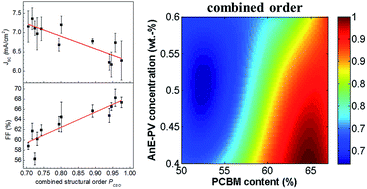Polymer aggregation control in polymer–fullerene bulk heterojunctions adapted from solution
Abstract
It is common knowledge that the polymer conformation and its phase separation with fullerene derivatives are delicate issues crucially impacting on the photovoltaic parameters of polymer based solar cells. While strongly intermixed polymer–fullerene phases presumably provide a large interfacial area and consequently a high quantum efficiency of exciton dissociation, pristine and primarily ordered polymer and fullerene domains may support efficient charge transport and its percolation. To study the aggregation and phase separation behaviour in polymer solar cells we investigated the counterbalancing influences of the polymer solution concentration and its blending ratio with PCBM ([6,6]-phenyl-C61-butyric acid methyl ester) on the basis of a semi-crystalline anthracene-containing poly(p-phenylene-ethynylene)-alt-poly(p-phenylene-vinylene) (PPE-PPV) copolymer statistically bearing branched 2-ethylhexyloxy and linear octyloxy side-chains (AnE-PVstat). The polymer aggregation was semi-quantitatively evaluated on the basis of its optical fingerprints and varied with both, the solution and the PCBM concentration, yielding a specific maximum within the parameter range studied. Upon relating photovoltaic parameters to the order within the polymer phase, the counterbalancing effect between charge generation and transport for increasing polymer aggregation is demonstrated, in agreement with sound hypotheses.


 Please wait while we load your content...
Please wait while we load your content...